

Anchor vs. Investigative Phenomena. The Next Generation Science Standards emphasize the importance of using phenomena to drive teaching and learning.

When thinking about phenomena, it’s important to understand the difference between the two kinds articulated by the National Research Council and NGSS: anchor and investigative phenomena. Anchor Phenomena Anchor phenomena are those observable, real-life contexts that form the basis of a question or a problem to be solved. They are very complex.
They represent questions we can’t answer in a single experiment or problems we can’t solve in one round of prototyping. An example of that might be flooding in New York City. When it comes to anchor phenomena, student questions and connections drive the teaching and learning. 5502j4. Atoms & Molecules Video For Kids. Claim-Evidence-Reasoning (CER) - Model Teaching. Argumentative reasoning is a skill that takes practice.

This means that students will not write a perfect CER response their first attempt. They will need guidance and support from you, the teacher, as they write CER answers over labs conducted in class. It is useful for the teacher to model a sample CER response with the students in the beginning. However, students should first attempt to write their own CER response from the lab prior to the modeling. As you discuss with the class your sample CER response make sure you are emphasizing the concepts for a successful claim, evidence, and reasoning answer. Students should use the CER Graphic Organizer resource as they continue to develop their writing skills and analyze their lab results.
Build an Atom - Atoms. Topics Atoms Atomic Structure Isotope Symbols Atomic Nuclei Description Build an atom out of protons, neutrons, and electrons, and see how the element, charge, and mass change. Then play a game to test your ideas! Sample Learning Goals. Low-Stakes Writing: Writing to Learn, Not Learning to Write. Covalent Bonds vs Ionic Bonds. (1) The wacky history of cell theory - Lauren Royal-Woods. Resources for science teachersThe New Science Teacher. Steps of Virus Infections (text version)
The flu virus is probably the first thing that comes to your mind when you hear the word virus.
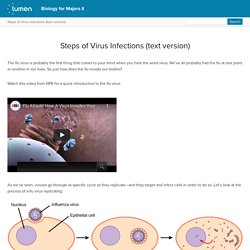
Writing a Research Paper for Your Science Fair Project. Overview Year after year, students find that the report called the research paper is the part of the science fair project where they learn the most.
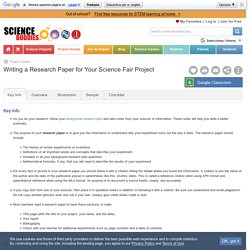
So, take it from those who preceded you, the research paper you are preparing to write is super valuable. Scientific Paper Format: How Must an A+ Paper Look Like? Have you been assigned to write a scientific project?

Then, it is high time to learn scientific paper format rules. This type of work has certain distinctive features and peculiarities, which you need to know to submit a well-structured assignment. Compared to an essay, which consists of one page, this assignment is a big project that includes several sections. iExploreScience. Teaching NGSS learning in the classroom! STEM curriculum for K-12 - TeachEngineering. Global Teaching Project - AP Biology Sample Lesson 9. Science Disciplinary Literacy: Enhancing Inquiry & Explanations. Synesthesia — The Wonder of Science. Teaching - Science/Technology. Four Stages of Cellular Respiration. Cellular respiration is the sum of the various biochemical means that eukaryotic organisms employ to extract energy from food, specifically glucose molecules.

The cellular respiration process includes four basic stages or steps: Glycolysis, which occurs in all organisms, prokaryotic and eukaryotic; the bridge reaction, which stets the stage for aerobic respiration; and the Krebs cycle and the electron transport chain, oxygen-dependent pathways that occur in sequence in the mitochondria. The Cell Image Library. CELLS alive! Study Aids. Pedagogy/Lessons. KS3 - BBC Bitesize. Plant and Animal Cell Worksheets. 10 Tips for Teaching Cells - Getting Nerdy Science. Graphic Organizers and Analogies: As students learn the names of all the crazy organelles found inside of bacteria, plant, and animal cells, the key to helping them remember the parts and functions is to use a cell organelle graphic organizer.
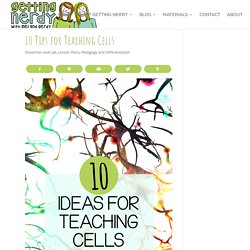
We like to give student a template for detailing what kind of cell has these organelles, their locations, brief description of their appearance, and their function. High School: Cellular Structure and Function. - National Science Teaching Association. Science Raps.
Lesson Plans. iCell App. Launch Tool iPadiPhoneiPod TouchAndroidWeb-based iCell gives you an interactive, 3D view inside a cell.
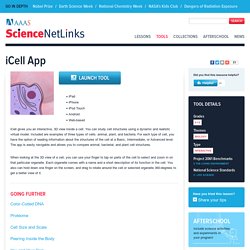
You can study cell structures using a dynamic and realistic virtual model. Included are examples of three types of cells: animal, plant, and bacteria. For each type of cell, you have the option of reading information about the structures of the cell at a Basic, Intermediate, or Advanced level. Home - Science NetLinks. Cell Size and Scale. Some cells are visible to the unaided eye The smallest objects that the unaided human eye can see are about 0.1 mm long.
That means that under the right conditions, you might be able to see an amoeba proteus, a human egg, and a paramecium without using magnification. A magnifying glass can help you to see them more clearly, but they will still look tiny. Smaller cells are easily visible under a light microscope. It's even possible to make out structures within the cell, such as the nucleus, mitochondria and chloroplasts. Biology 2e – Open Textbook. Book Description Biology 2e is designed to cover the scope and sequence requirements of a typical two-semester biology course for science majors.
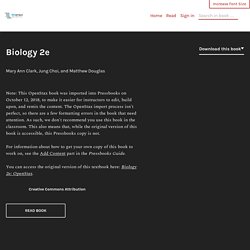
The text provides comprehensive coverage of foundational research and core biology concepts through an evolutionary lens. Biology includes rich features that engage students in scientific inquiry, highlight careers in the biological sciences, and offer everyday applications. Tissue quiz - Biology 141 with Dr. at Lewis and Clark Community College. Teacher Tools. Teacher Programs JLab Science Activities for Teachers (JSAT) - An afternoon science program for 5th, 6th and 8th grade teachers.

[Program Dates: September 2020 - May 2021] Teacher Night at Jefferson Lab - Teacher Night will be held on April 1st, 2020. Please sign-up by March 30th, 2020! Education Events. Crash Course Kids. Build A School Garden. Nature Lab (The Nature Conservancy) Science Resources - Mrs. Mosteller's 5th Grade Adventures. Cells, Unicellular Organisms, and Multicellular Organisms. 7th grade Science. Welcome Back! Hi everyone! As we enter into the last semester of the marking period, I hope you are refreshed and ready to finish strong! Here are the lesson plans for the week of 4/8/13: Monday 4/8/13 Objective: Review and reset classroom expectations. Unicellular and Multicellular Organisms Lesson Plans. Lesson Plans. 7th Grade NGSS Lesson Plans. OER Commons - NGSS MS LS.
TeachersFirst.com - MS Biology-LS. Smithsonian Science. Skip to Content Subject Age Range Educational Features Language End User Educational Use Time Required. Smithsonian Education Guides 5-22-20. Science - Learner.org.